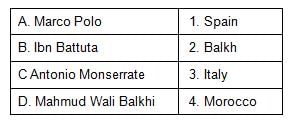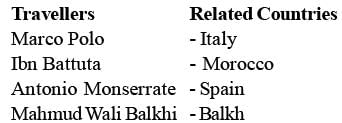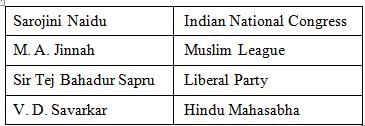SSC CGL Previous Year Questions: History - 8 - SSC CGL MCQ
30 Questions MCQ Test - SSC CGL Previous Year Questions: History - 8
The treaty of Versailles restored Alsace-Lorraine to: (SSC CGL 2nd Sit. 2012)
The Asokan Edicts were deciphered first by: (SSC CGL 2nd Sit. 2012)
Who favoured the Artic Home thoery of the Aryans? (SSC CGL 2nd Sit. 2012)
Who was the teacher of Gautama Buddha? (SSC CGL 2nd Sit. 2012)
The prose collection of the vedic poems are: (SSC CGL 2nd Sit. 2012)
Non-violence as taught and practised by Mahatma Gandhi is rooted in the Indian Doctrine of (SSC CGL 1st Sit. 2012)
Who was the founder of the Aligarh Movement ? (SSC CGL 1st Sit. 2012)
‘Prince of Pilgrims’ was the name attributed to (SSC CGL 1st Sit. 2012)
Where did Buddha deliver his first sermon ? (SSC CGL 1st Sit. 2012)
Name the Mughal Prince, who translated Bhagavat Gita into Persian ? (SSC CGL 1st Sit. 2012)
The surgery that was practised in ancient India is known from the works of which of the following scholars ? (SSC CGL 1st Sit. 2012)
Who among the following was the First Viceroy of India? (SSC CGL 2nd Sit. 2012)
Prithvi Raj Chauhan was defeated in the Second Battle of Tarain by (SSC CGL 2nd Sit. 2012)
The original name of Nana Phadnavis was (SSC CGL 2nd Sit. 2012)
Who among the following first propounded the idea of Basic Education? (SSC CGL 2nd Sit. 2012)
Arrange the following in chronological order: (SSC CGL 2nd Sit. 2012)
I. Dandi March
II. Simon Commission
III. Poona Pact
IV. Gandhi Irwin Pact
The city of Prayag was named Allahabad - the city of Allah by (SSC CGL 2nd Sit. 2012)
The use of which of the following regional languages was popularised by the Bhakti leader, Shankaradeva ? (SSC CHSL 2012)
The Mansabdari system was introduced by: (SSC CHSL 2012)
When and by whom were the Asokan inscriptions deciphered for the first time ? (SSC CHSL 2012)
Amuktamalyada is the work of : (SSC CHSL 2012)
The French challenge to British in India came to an end with (SSC Sub. Ins. 2012)
Identify the medical trio of Ancient India from the following names. (SSC Sub. Ins. 2012)
Match the medieval travellers with their countries : (SSC Sub. Ins. 2012)

The Greek ambassador sent to Chandragupta Maurya's Court was : (SSC CGL 1st Sit. 2011)
Identify the European power from whom Shivaji obtained cannons and ammunition: (SSC CGL 1st Sit. 2011)
The call of "Back to the Vedas" was given by: (SSC CGL 1st Sit. 2011)
Simon Commission was boycotted by the nationalist leaders of India because: (SSC CGL 1st Sit. 2011)
Who among the following British persons admitted the Revolt of 1857 as a national revolt? (SSC CGL 1st Sit. 2011)

















